China's Belt and Road Initiative Threatens to Pave the Planet
The Chinese government is laying plans for trillions of dollars of new ports, rail lines, and roads across the globe
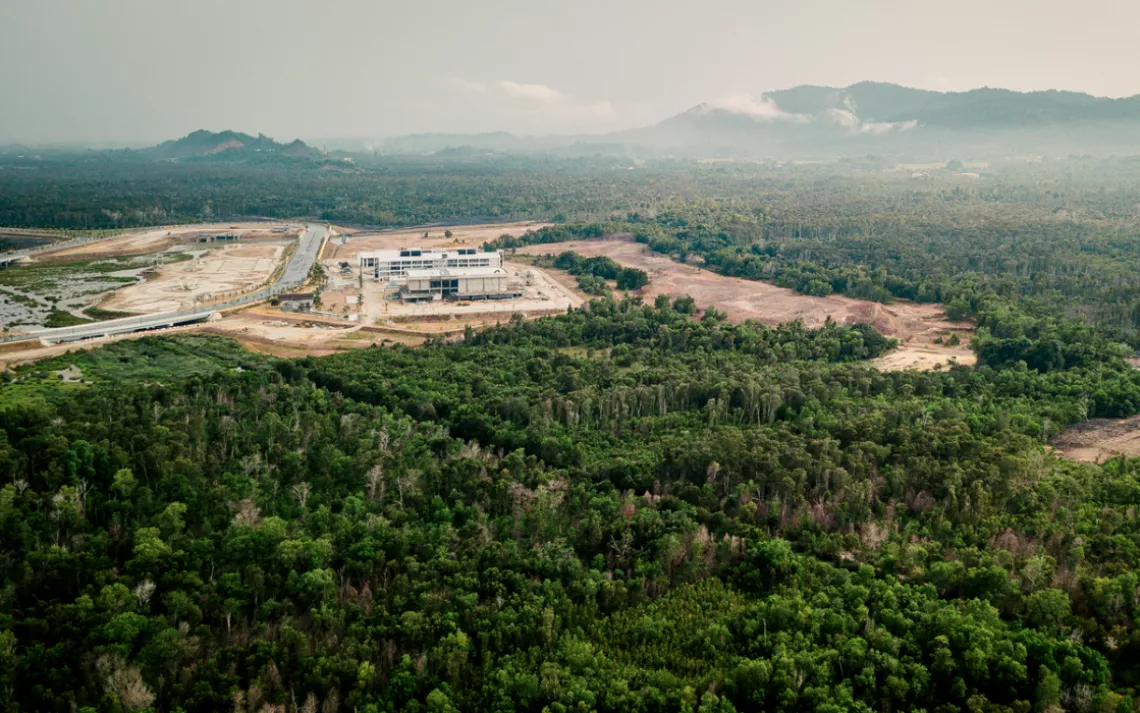
A section of the East Coast Rail Link outside the city of Kuala Terengganu in Malaysia. | Photos By Ian Teh
IN 1965, AS A MONSOON LASHED the Malaysian island where Tengku Azam's family had lived for more than a half century, his grandfather led them across a lagoon and through a swampy forest to drier ground inland. The tree canopy was thick, and when the family settled about a mile away from their slowly eroding island, they named their new home Dark Landing.
Tengku, who was 17 at the time, had spent his childhood learning about the marine life that swirled around Dark Landing's mangroves and nipa palms. When he retired from fishing as he neared 70, he set up a school to educate local fishermen's children about the same clams, fish, and painted terrapins at which he had once marveled in the lagoon, the ones that had adapted over centuries to its brackish waters. "It's my responsibility to make sure our fishing heritage is protected," Tengku, who has the agility of a man half his age, told me recently on his front porch. (In Malaysia, as in China, names are typically rendered surname first.)
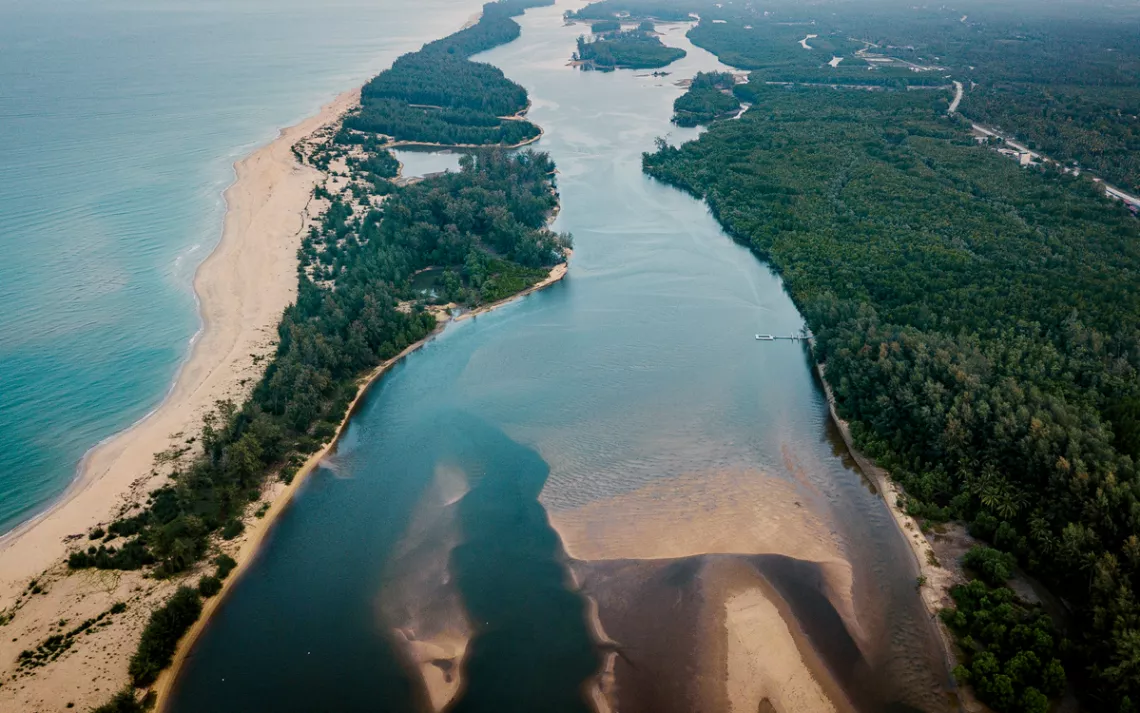
Wetlands in Malaysia's Setiu District
Tengku's ethic of stewardship also spurred him to convince the authorities in his native state of Terengganu to formally protect part of the local wetlands. The result was Setiu Wetlands State Park, which was established in 2018 near the lagoon and the adjacent South China Sea. It is about the size of New York's Central Park and includes both the island where Tengku was born and the mangrove forest through which his grandfather once led the family to Dark Landing.
The park is a small part of what scientists say may be the most ecologically interesting complex of wetlands in Malaysia—one that has faced severe environmental threats for much of Tengku's adulthood. For decades, the Setiu District has experienced a steady encroachment of palm-oil plantations and sand-mining operations as well as upstream logging in the highlands that lie inland from the swamp. All that development has created profits for Malaysian conglomerates and jobs for local workers but has strained the hydrological systems that regulate the delicate balance of fresh and salty water in Setiu's lagoon and estuaries. It has also fueled erosion, both in upstream forests and along a wide sandbar that separates the lagoon from the sea.
Now comes a new threat: a 400-mile, cross-country railroad financed by the Chinese government that is scheduled to cut through Setiu. Biologists say that the railroad would likely disrupt the waters that flow from the mountains into the lagoon—in the process potentially pushing the wetlands toward their ecological breaking point. Changes in salinity could kill freshwater flora and fauna, they say, while the reduced water flow could exacerbate erosion on the sandbar, allowing the South China Sea to overwhelm the lagoon.
The multibillion-dollar project, known as the East Coast Rail Link, is one of many that fall within China's Belt and Road Initiative, a colonial-style endeavor that links infrastructure loans with geostrategic diplomacy. The BRI is part of China's larger effort to project its own institutions as alternatives to the Western-led order represented by the World Bank and the International Monetary Fund. Some see the initiative as a 21st-century riposte to the Marshall Plan, the post–World War II American campaign to finance infrastructure and maintain a US military presence in parts of Europe that were not under Soviet control.
The BRI is deeply rooted in Chinese politics. Since the 1990s, China's economic boom has been driven in part by state-financed investments in domestic infrastructure. Chinese engineers have built the world's largest high-speed rail network, with over 15,000 miles of dedicated track completed since 2008. But as the Chinese economy slows, and as Beijing and Washington square off in a bitter trade war, China's ruling Communist Party is pursuing overseas infrastructure projects as a way to keep domestic business churning.
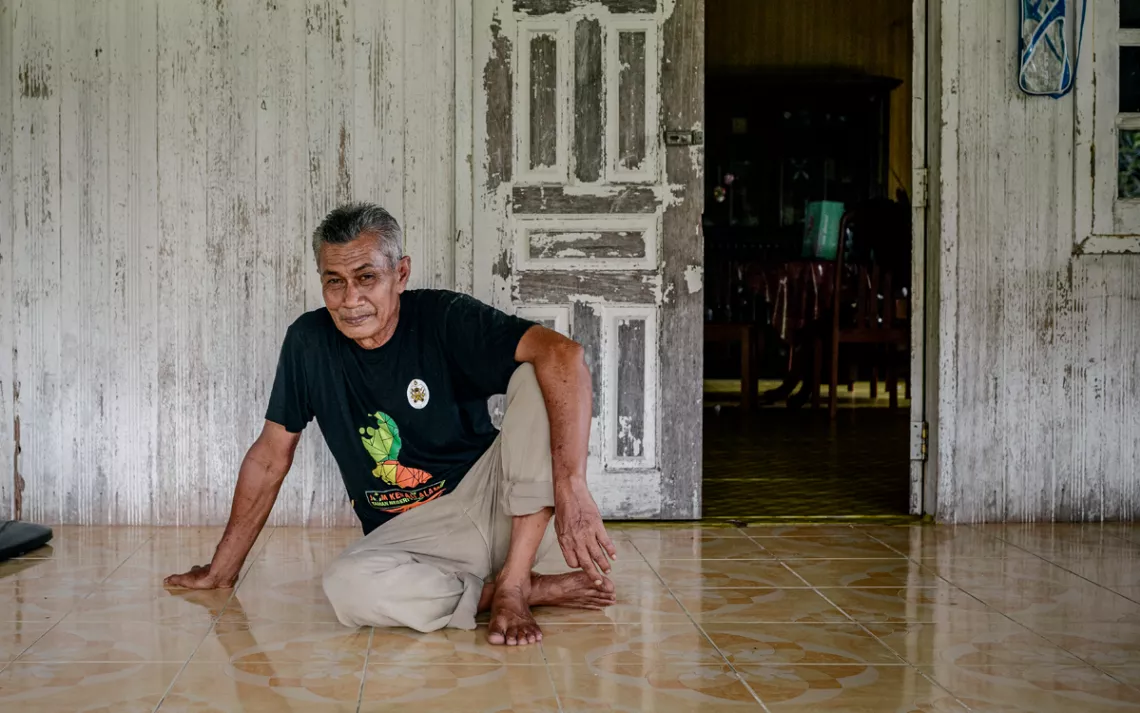
Tengku Azam is a retired fisherman who spearheaded the effort to create Setiu Wetlands State Park.
It would be difficult to overestimate the BRI's scale. The project, which launched in 2013, could end up involving as many as 125 countries and costing $8 trillion by 2049. Top Chinese officials have described it as a vast network of roads, rail lines, and maritime shipping routes that will radiate outward from China's land and sea borders like a spiderweb. It will eventually include oil and gas pipelines in Myanmar, Russia, and Kazakhstan; highways in Pakistan; a railroad in Kenya; hydropower dams in Cameroon and Zambia; and dozens of other projects across Asia, Africa, and Europe.
The Belt and Road Initiative is so enormous that its impacts could erode the gains that China and other countries have made in recent years in fighting climate change and other pressing environmental problems. China has significantly tightened its domestic environmental laws since the 1990s, and it says that the BRI will hew to the same rules. Yet many Chinese companies apply weaker environmental standards abroad than they do at home, and many conservation experts are skeptical about Beijing's assurances. William Laurance, an authority on the BRI at James Cook University in Australia, wrote that the project is part of a global "tsunami" of infrastructure development that is mostly driven by China. He warns that it threatens to "open a Pandora's box of environmental crises, including large-scale deforestation, habitat fragmentation, wildlife poaching, water pollution, and greenhouse gas emissions."
CHINA'S RISE is the geopolitical story of the 21st century; its infrastructure plans outline the ambitions of a nascent superpower. The Belt and Road Initiative is also a signature of the age of Xi Jinping, the country's most powerful leader since Mao Zedong. He launched it the year after coming to power and has called it the "project of the century."
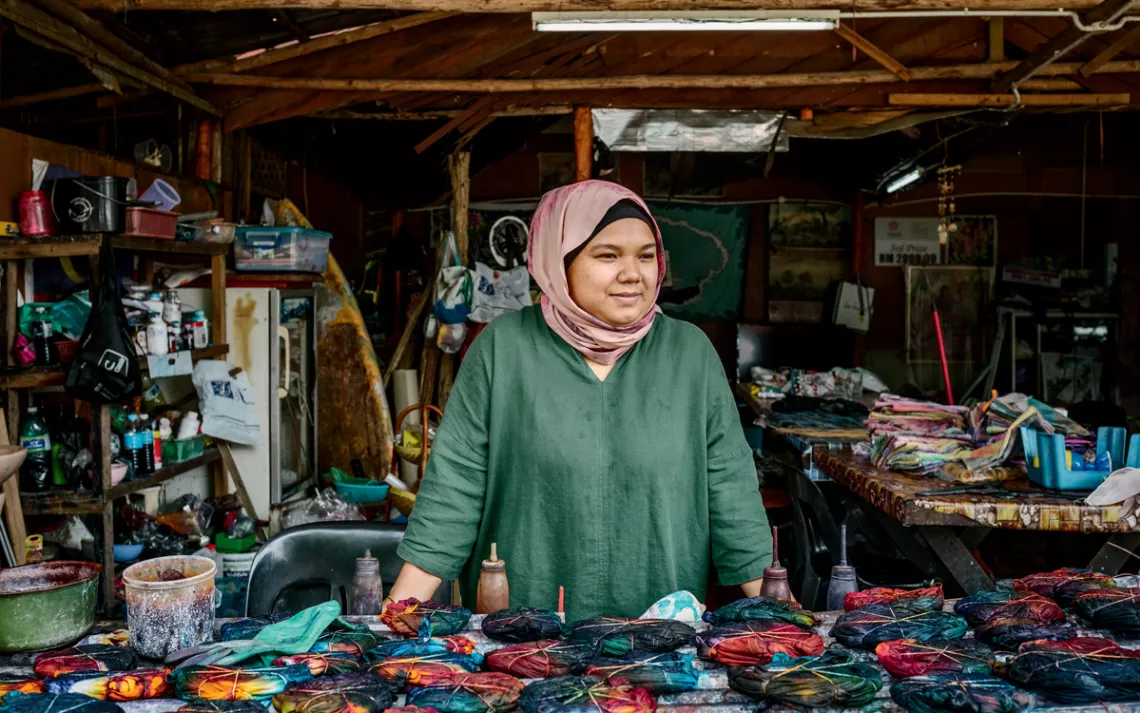
Amaleea Hayu, a Malaysian shop owner, supports the rail project.
The BRI is designed to speed the movement of goods to and from China while boosting investments by state-affiliated companies in steel plants, coal-fired power stations, and other markers of Beijing's expanding industrial footprint. China also plans to diversify its energy sources and reduce its need to move oil through geopolitical hot spots like the Persian Gulf and the South China Sea.
Malaysia's East Coast Rail Link, scheduled for completion in 2026, fits perfectly into China's larger plans. It will connect two parts of Malaysia that don't have much in common—the cosmopolitan west and the conservative east—and allow cargo to move from the capital, Kuala Lumpur, toward Kuantan, an eastern port city on the South China Sea. From there, the railroad will head north up the rural east coast, passing Setiu, and end at Malaysia's border with Thailand—but not before stopping at a billion-dollar industrial park in Kuantan that opened in 2017 and is dominated by Chinese companies.
When China invests in so-called frontier economies like Malaysia's, the parameters of its infrastructure projects are often fixed once they have been financed and approved, said Alex Lechner, a landscape ecologist at the University of Nottingham's Malaysia campus who studies the BRI. "Millions of dollars have been invested, and the environment becomes an obstacle to be overcome," he told me. That may be true for Setiu, where the railroad company's Chinese contractor has already built a giant factory in the swamp. Even Tengku has not been told where the tracks will go—or whether the contractor plans to do environmental mitigation in the area.
When protected areas are bisected by infrastructure projects, they tend to be vulnerable to secondary threats like poaching and illegal logging.
Setiu sits along a coastline flanked by tin-roofed homes, wooden fishing boats, and the spires of village mosques. When I visited last summer, the coastal scenes reminded me not of western Malaysia but of rural places I had visited in poorer Southeast Asian countries like Cambodia and Myanmar. The area felt worlds away from Kuala Lumpur's garish high-rises and shopping malls.
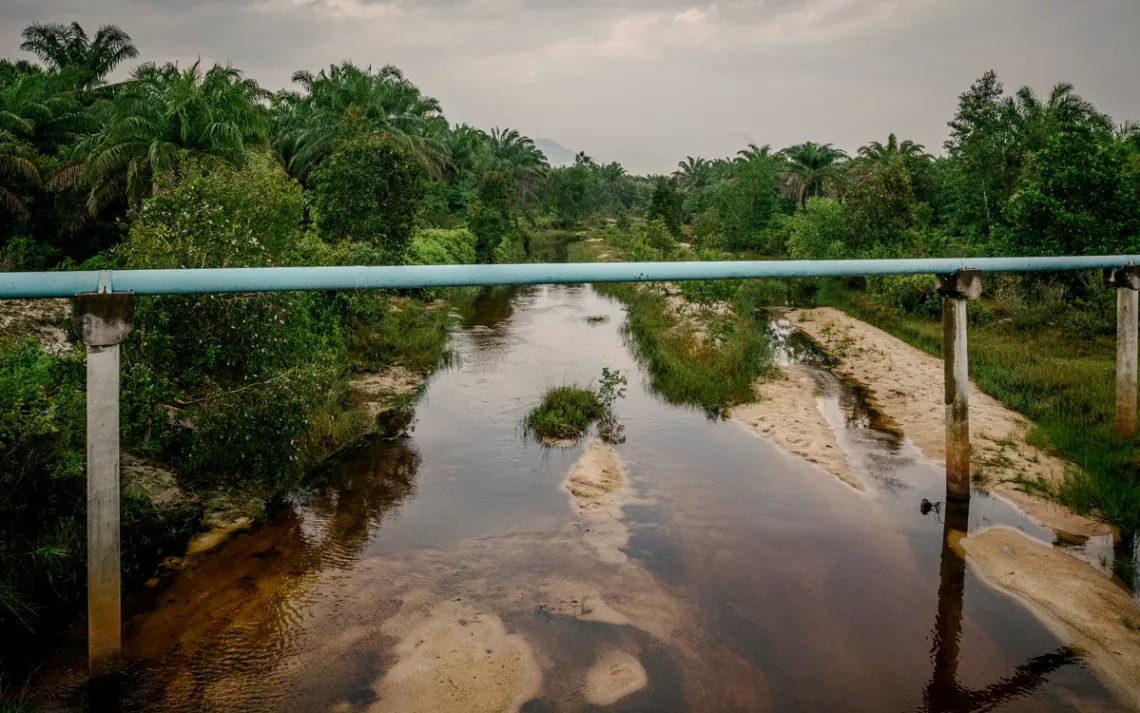
Development has already impacted river flows.
A few rail sections were already under construction south of Setiu, mostly in and around the peatlands that run north and south along Malaysia's east coast. It was tempting to think that some of the railroad's obvious economic upsides—construction jobs, tourists from Kuala Lumpur—would outweigh its environmental risks. What was the harm in draining a swamp or two?
This is essentially the view of the Malaysian government and the consultancy that it paid to study the railroad's likely environmental impacts. A 138-page summary of a 2017 environmental impact assessment of the railroad's initial route talks at length about how the design would mitigate the fragmentation of forests and wildlife habitats. The word "peat" appears just three times; "swampy" once; "wetland" not at all.
But peatlands, which occur across a vast area of Malaysia, are more complex than they look. The term peatlands refers to both surface wetlands and the porous soil beneath, which forms from dead, waterlogged plants. Because peatlands store groundwater and regulate a wetland's salinity, some scientists liken them to kidneys. The environmental impacts can be substantial when they are drained.
In recent decades, developers across Malaysia have converted peatlands into palm-oil plantations, aquaculture farms, and industrial zones, while logging companies have destabilized upstream watersheds by clearcutting virgin forests. "Per hectare of land, you create more money and jobs than leaving it as a wetland," Edlic Sathiamurthy, a paleohydrologist who studies the watersheds of Malaysia's east coast, told me. "That's always the justification."
Palm oil may have earned Malaysian tycoons billions of dollars, but the peatland conversion process has been linked to severe environmental problems, including land-clearing fires that spew carbon dioxide into the atmosphere and flash flooding triggered by groundwater drainage. Edlic told me that while the East Coast Rail Link might only graze Malaysia's Central Forest Spine—a network of protected areas known for their exceptional biodiversity—much of it would be built in and around peatlands.
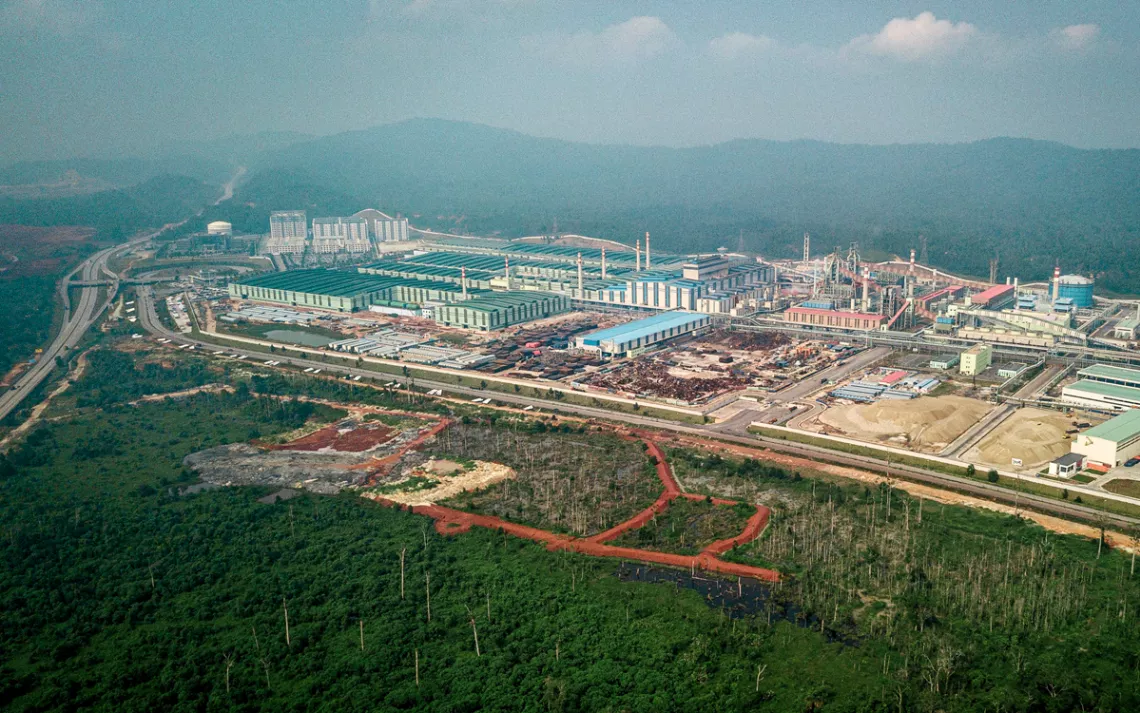
The Kuantan Industrial Park is dominated by Chinese companies.
Setiu is particularly vulnerable to the railroad's impacts, Edlic said, because it has a unique topography: peatlands, estuaries, mangroves, and a lagoon with high biological diversity, all jammed onto a narrow plain between the coast and a mountain range. The railroad could disrupt the area's delicate ecological balance to a point of no return—effectively destroying the habitats that once transfixed a young Tengku. "This is a very highly erodible environment," Edlic told me. "Once it gets eroded, we're not talking in terms of years. We're talking in terms of months."
OFFICIALS IN BEIJING SOMETIMES describe the Belt and Road Initiative as a modern variation on the ancient Silk Road—the trade routes that linked merchants from imperial China to the outside world. The BRI will embody the "Silk Road Spirit," the Chinese government said in a 2015 mission statement. "Reflecting the common ideals and pursuit of human societies," it said, "it is a positive endeavor to seek new models of international cooperation and global governance, and will inject new positive energy into world peace and development."
Or perhaps not. Many economists and development experts say that China is essentially offering cheap infrastructure loans to poorer countries as a type of political coercion. One glaring example is a Sri Lankan port that a state-owned Chinese firm plowed money into despite clear signs that the local government could never afford it. China recently took over the port—which happens to be strategically placed near India, a geopolitical rival—as debt collateral. The move prompted criticism that Beijing was engaging in a textbook example of "debt-trap diplomacy."
President Xi has denied that the BRI is a vehicle for political coercion or the expansion of the Chinese influence. "The Belt and Road Initiative is an economic cooperation initiative, not a geopolitical or military alliance," he said last year. "It is an open and inclusive process and not about creating exclusive circles or a China club." But whatever one thinks of China's ambitions, one thing is clear: The BRI's giant industrial footprint will be so vast that the environmental costs are bound to be huge.
Evaluating the environmental merits of BRI projects is tricky because many of them are shrouded in secrecy, propaganda, and endless bureaucracy. President Xi has said that he is committed to pursuing BRI projects that support "green, low-carbon, circular, and sustainable" development. Yet while China has made strides recently to flatten its greenhouse gas emissions, some climate experts fear that the BRI's sheer size will inevitably boost resource extraction and fossil fuel consumption. For example, the BRI will intensify dependence on fossil fuels by facilitating the shipment of oil and gas and financing the construction of new coal-fired power plants. Such concerns are especially acute in Southeast Asia, a region with exceptional biodiversity, a growing population, and plans to build hundreds of coal-fired power plants by 2030.
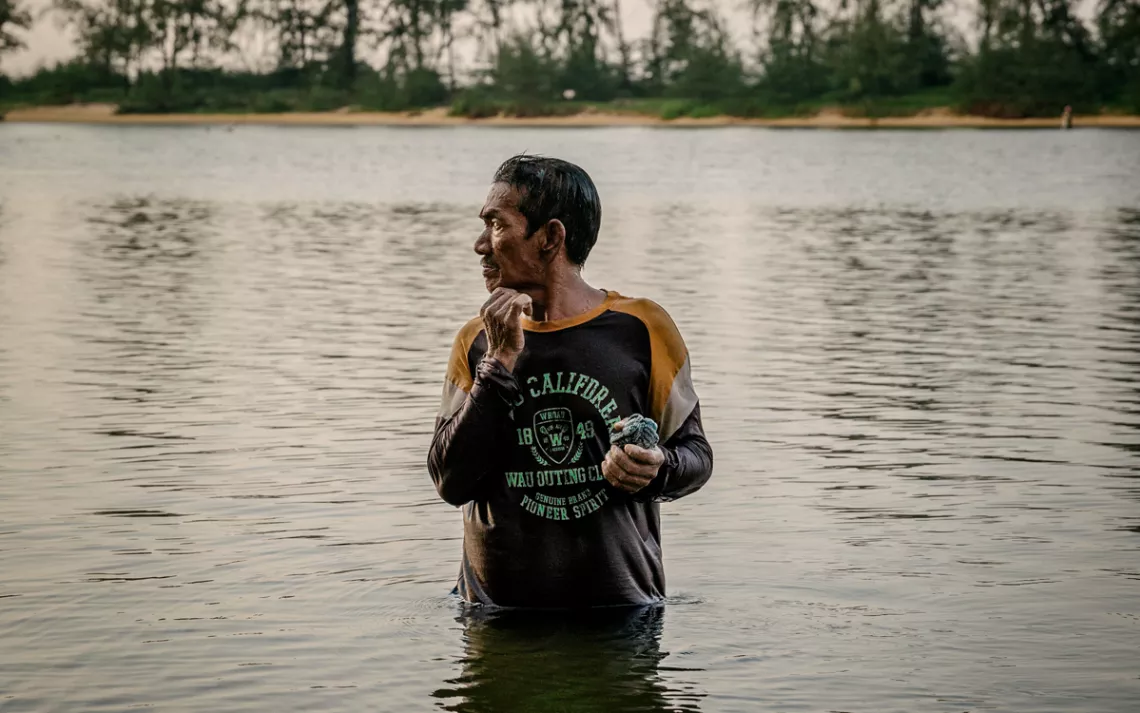
Only locals are permitted to fish in Setiu Wetlands State Park.
Biologists worry that BRI projects will cut through rainforests, peat swamps, and other ecologically sensitive areas—a thousand Setius—without much consultation with local residents or environmental experts. Road and rail projects around the world have already severely impacted ecologically sensitive areas, and a raft of new BRI projects may push local ecosystems beyond their tipping points, seven environmental scientists wrote recently in the journal Nature Sustainability.
Not every BRI road and railroad will belch coal or destroy pristine rainforests, of course. Yet a recent study in Conservation Biology found that proposed BRI road and rail routes would overlap with biodiversity hot spots for over 4,138 animal and 7,371 plant species across Asia and Africa. That's a problem, because when protected areas are bisected by infrastructure projects, they tend to be vulnerable to secondary threats like poaching and illegal logging.
"A lot of environmental scientists feel like we're at this crossroads," Lechner, the landscape ecologist, told me. "We've got climate change that's out of control and biodiversity loss and land-use change, and in Southeast Asia we have oil palm—there are all these critical things all happening at this critical moment in time. And sometimes you think, 'Do we really need BRI to be adding to that?'"
The risks for environmental harm are particularly rife in countries with high levels of biodiversity and low standards of public transparency. Malaysia is among the most biodiverse places on Earth, and its political elites are almost cartoonishly corrupt—for example, Najib Razak, the former prime minister, who first approved the East Coast Rail Link. Months after losing the 2018 election, Najib was charged in connection with a graft scheme in which about $4.5 billion was pilfered from his own government. A witness later testified that Najib had offered the East Coast Rail Link (worth about $16 billion at the time) to Chinese investors as a way to make his other debt problems disappear.
SETIU'S UNIQUE GEOLOGY has been forming since the South China Sea retreated thousands of years ago, leaving lagoons behind as if they were puddles after a rainstorm. Today, the place is an ecological gem: a series of nine interconnected ecosystems spanning sea, beach, mudflat, lagoon, estuary, river, islands, coastal forest, and mangrove forest. Scientific papers speak of Setiu in almost reverent terms. Tengku told me that when he asked the royal family in Terengganu to declare some land near the lagoon a protected area, they agreed almost immediately.
Setiu Wetlands State Park covers about 2 percent of the area's total wetlands and sits within walking distance of Tengku's home in Dark Landing. On a scorching summer day, Tengku walked me through the park, our cheeks brushing the edges of nipa palms. After about 15 minutes, we emerged at the brackish lagoon where he fished for more than a half century.
Tengku told me that he'd always been fascinated by the interdependence of Setiu's ecosystems. The lagoon is a mix of freshwater from the mountains and saltwater that enters through an inlet. Over the centuries, complex communities of fish, turtles, and mollusks have developed routines calibrated to the lagoon's salinity. "If the salinity here changes, the fish won't survive," he said.
As Tengku spoke, one of his neighbors, Panoha Nawi, waded through the water carrying a sack of clams that he had harvested from the lagoon's muddy bottom. He planned to sell his catch in a nearby town for about $12. One condition of the state park's designation was that only local fishers would be allowed to go clamming within the preserve, and Panoha said that the measure had clearly boosted the harvests. "Before, there was too much competition," he said.
Tengku said that if the state park was an example of how the area's delicate ecology could be successfully conserved, everything else that was happening in and around Setiu—aquaculture, sand mining, palm-oil cultivation—underscored the threats to its future. Investors may have spent money on those activities to turn a profit, he added. "But they didn't really see into the future."
The next day, Tengku took me to see the threats. Our first stop was the shores of the South China Sea, where a local sand-mining company had built an export pier. From a distance, and through the early-morning haze, the sand-loading site looked innocuous. But the company, Terengganu Silica, has said that it can load 800 tons of sand per hour. Tengku said he worried where all that sand would come from.
From the beach, we drove a few miles inland, to a jetty on the lagoon where a fishing boat had just come in from the sea. As a heavy rain started, Tengku stood under an open-air shelter watching the fishermen unload their catch. A storm had forced them to come in early, and their haul—around 44 pounds—was about a quarter of what it might have been on a big day.
Ibnur Sirien, a 22-year-old fisherman on the boat, said that most of his friends had already migrated to Malaysian cities as laborers; he had stayed behind partly because his father owns the boat. Echoing a scientific consensus, Ibnur told me that the South China Sea fishery has been steadily declining in recent years. "But there's not much other work here," he said.
Our next stop was farther inland. Tengku stopped his 4x4 truck at a bridge that crossed a stream, then clambered down a bank and stood, shin deep, in the current. The stream once ran several feet higher and much cleaner at this time of year. But a few years ago, he said, a company cut the local cashew trees and replaced them with a palm-oil plantation, lowering the surface-water flow and quality. And because the stream emptied into the lagoon, the impacts were felt miles away. "The pollution here affects the whole ecosystem," he said.
Surface-water pollution isn't the only consideration. Hydrologists study "base flow," a measure of how much water seeps into a stream or river from below. It's a wonky term, and one that isn't mentioned in the environmental report on the East Coast Rail Link. But base flow matters in a place like Setiu because groundwater beneath peatlands helps to maintain surface-water salinity. And, as Tengku said, fish don't like changes in their habitat.
Edlic, the paleohydrologist, told me that because Setiu sits on a narrow coastal plain, the railroad will have to pass through it one way or another. The key question, he said, is whether the developer will pay to elevate the train tracks on stilts that extend to bedrock. The cheaper option would be to build directly on the peatlands, further impeding the base flow that moves freshwater from the mountains into Tengku's favorite lagoon. "It all depends on how they actually do the construction," Edlic said.
POWERFUL CIVILIZATIONS—Rome and Persia and ancient China itself—have always built roads and other infrastructure as a way to bolster their traders and militaries. One of history's biggest infrastructure builders has been the United States, which has projected its geopolitical agenda through its controlling stakes in the World Bank and the International Monetary Fund, which finance road, rail, and hydropower projects across the developing world.
China's Belt and Road Initiative appeals to countries that are spooked by President Trump's insular "America First" vision and believe Beijing's investments will help guarantee their long-term security and prosperity. Malaysia, for one, has long been an important US ally in Southeast Asia, but it also has strategic reasons to get along with China. It has a large ethnic Chinese population and a prime position on the South China Sea, where Beijing is building military bases on artificial islands.
China has said that Malaysia is strategically located along the "Maritime Silk Road," and the East Coast Rail Link is among the largest infrastructure projects in the BRI catalog. In the run-up to Malaysia's 2018 election, Najib Razak's challenger, Mahathir Mohamad, tied Najib to the rail project to paint him as a pro-China lackey. But after Mahathir won, he decided to renegotiate the project instead of canceling it. He later said that the rail link would go ahead, for about two-thirds of the earlier price, partly because the $5 billion penalty for canceling it would be too expensive for a country with massive debts.
Mahathir's announcement included a silver lining for environmentalists: The East Coast Rail Link's revised route would mostly avoid crossing Malaysia's Central Forest Spine. But because Mahathir's government did not release its exact plans, some environmental groups continued to worry. I.S. Shanmugaraj, the executive director of the Malaysian Nature Society, told me last summer that many scientists and environmental groups remained in the dark about the project's scope.
The project's developer, Malaysia's state-owned rail operator, engaged the same outside consulting firm that studied the original route's environmental impacts in 2017. But Shanmugaraj told me that the firm was hardly impartial. "If the consultant is tied to the developer," he asked, "even though it's selected by the government and they are licensed, at the end of the day, who's the paymaster?"
(A spokesman for the firm, ERE Consulting Group, told me that he could not comment without prior approval from Malaysia Rail Link, which did not respond to an emailed request for comment. The project's principal contractor, China Communications Construction Company, also did not respond to an email. None of the three agreed to give Sierra a copy of any project documents.)
Some observers wonder if Malaysia, which is groaning under the weight of debts, really needs a new railroad. They note that an existing passenger rail line, which was built by British colonial authorities in the early 20th century, already connects Kuala Lumpur to the rural northeast.
Others, however, are eager for the new rail connection. On my trip along Malaysia's east coast, I met several people who welcomed the project. One was Amaleea Hayu, who runs a tie-dye shop in Cherating, a beach town known for its surf breaks. We spoke on a summer morning at a seaside restaurant that served coffee with roti canai, Indian-style bread with curry. It was the off-season, and business was slow. She said that a train stop in Cherating could be the perfect catalyst for attracting tourists from Kuala Lumpur. "It sounds great," she said.
Even Lee Chean Chung, a state legislator who has been a vocal critic of the environmental impacts of mining and logging concessions, was guardedly optimistic. Lee told me that he supported the plan because it would bring jobs and trade to Kuantan, where his constituents live. He noted that Kuantan's industrial park, built largely through Chinese investment, is a major part of the region's economic-development agenda.
"But the thing is, on the east coast, environmental concerns are generally lower," Lee told me over lunch in Kuantan. He added that while Chinese manufacturers and logging firms operating in eastern Malaysia had grown less "reckless" over the years, the local authorities still have a deplorable record when it comes to policing illegal logging and industrial pollution. "How can you make sure, when this megaproject is conducted, that you have enough people to do the checking to make sure they do not encroach onto forestlands? Or, if there is precious timber to be taken away, how do you make sure they will not try something funny?" he asked. "They are exploiting our regulations to their advantage."
BACK IN SETIU, Tengku drove farther into the wetlands and parked his truck beside a blue factory the size of an airplane hangar. The marquee read "China Communications Construction Company." Beside photos of a bridge across China's Yangtze River, a sign said "Connecting lives. Accelerating growth."
Tengku, hands on his hips, walked the building's perimeter warily, as if looking for a way inside. Near one corner, he found a Malaysian worker in jeans and sneakers, who explained that the building was a fabrication plant for making railroad equipment. The man, who declined to give his name, said that about half the workers were local and the other half—mostly managers and engineers—were from China.
The worker was loading engine oil and coolant into a generator, but only after he had wedged his truck into a ditch and tossed a hose over the factory's fence. He said it was an awkward and needlessly dangerous setup. Tengku asked why it had to be that way, and the man replied that the contractor had apparently built the walls and entrances of this factory without fully thinking through the logistics.
"They're just trying to cut costs," he said.
This article appeared in the January/February 2020 edition with the headline "The Train and the Swamp."
Shovel Ready
The Chinese government plans to remodel the globe's architecture. Here's a snapshot.
-
$50 billion
Amount China has already spent on BRI-related energy projects$1.3 trillion
Amount China may invest in Belt and Road countries by 2027$8 trillion
Minimum estimated cost of the BRI by 2049 -
105,711 miles
Length of proposed BRI roads based on current plans46,876 miles
Length of the US interstate highway system -
49,989 miles
Length of proposed BRI rail lines based on current plans140,000 miles
Length of the US freight rail network -
28,278,527
Tons of cement it would take to build the proposed BRI rail lines15%
Cement production’s current share of China’s CO2 emissions46,876 miles
Length of the US interstate highway system -
91,222
Estimated number of protected areas that may be affected by BRI projects265
Estimated number of threatened, endangered, or critically endangered species in planned BRI corridors
The Chinese government plans to remodel the globe's architecture. Here's a snapshot.
- POWER GRID INVESTMENT
Country: Greece
Status: Complete
Cost: $360 million
The investment was small by comparison with other BRI projects but illustrates how the initiative extends far beyond Asia and Africa. - PORT QASIM POWER PLANT
Country: Pakistan
Status: Complete
Cost: $2 billion
Critics say the coal plant will exacerbate Pakistan’s long-term dependence on fossil fuels. - KARUMA HYDROELECTRIC POWER STATION
Country: Uganda
Status: Under construction
Cost: $1.4 billion to $1.7 billion
This 600-megawatt project sits within a national park and has been criticized for its likely environmental impacts. - HAMBANTOTA PORT DEVELOPMENT PROJECT
Country: Sri Lanka
Status: Complete
Cost: $307 million (estimate)
The port had been predicted to fail economically, and it did, prompting China to buy a controlling equity stake in 2017. - LAOS-CHINA RAILWAY
Country: Laos
Status: Under construction
Cost: $6 billion
The 3,000-mile railroad is among the largest Belt and Road projects underway; critics have accused the developer of downplaying the environmental impacts. - PHNOM PENH–SIHANOUKVILLE EXPRESSWAY
Country: Cambodia
Status: Under construction
Cost: $1.6 billion to $2 billion
The 118-mile highway will be the first to link the Cambodian capital, Phnom Penh, with the port city of Sihanoukville.
 The Magazine of The Sierra Club
The Magazine of The Sierra Club



